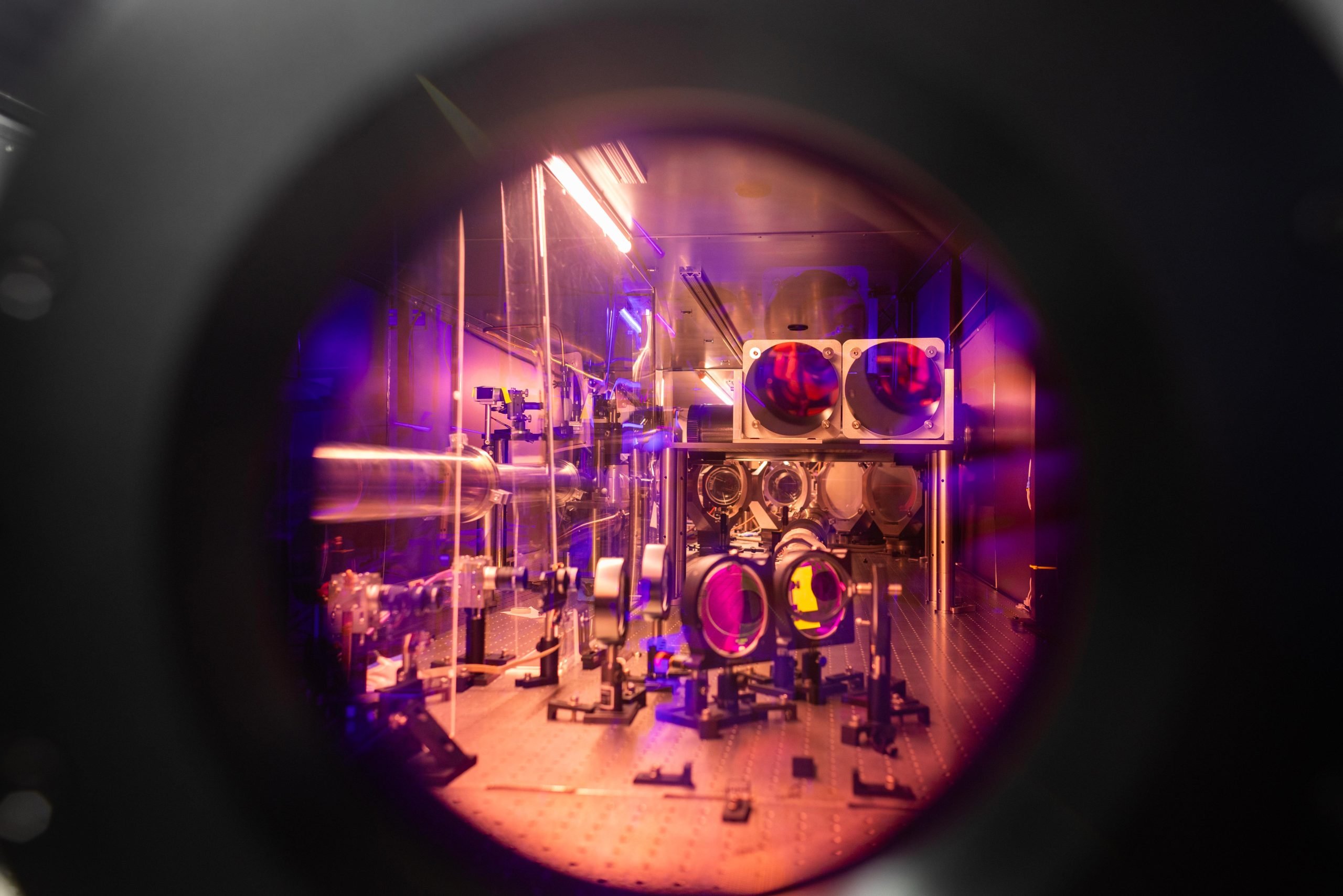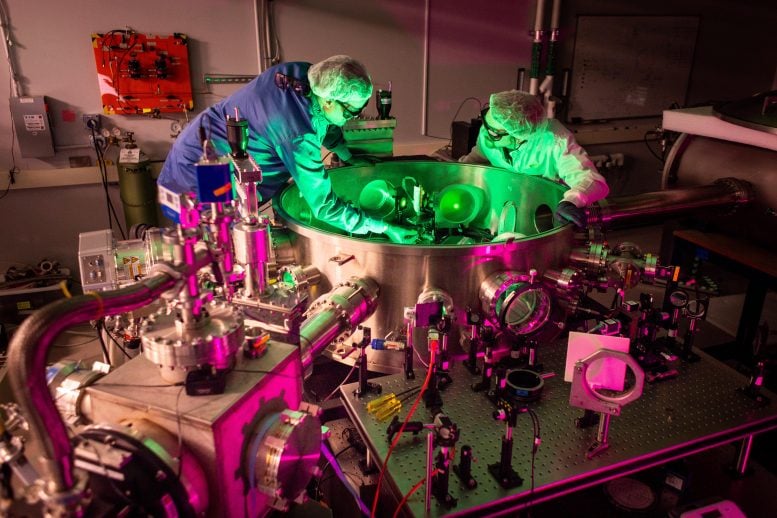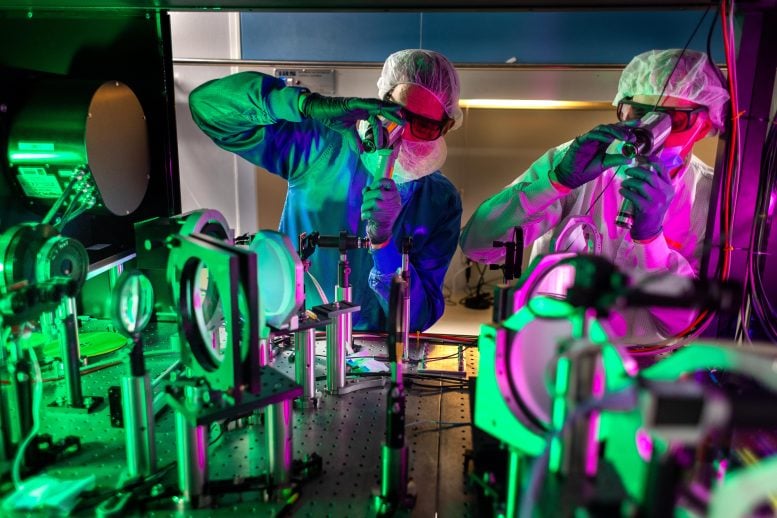America’s Most Powerful Laser Fires Its First 2-Petawatt Shot

Reaching 2 petawatts of power, the NSF-funded ZEUS facility at the University of Michigan supports research with potential benefits for medicine, national security, materials science, and other fields.
The ZEUS laser facility at the University of Michigan has achieved its first official experiment at 2 petawatts (2 quadrillion watts), nearly doubling the peak power of any other laser currently operating in the United States.
Exceeding the total electricity produced worldwide by more than 100 times, this immense burst of power exists only for the extremely short span of a laser pulse, just 25 quintillionths of a second.
“This milestone marks the beginning of experiments that move into unexplored territory for American high field science,” said Karl Krushelnick, director of the Gérard Mourou Center for Ultrafast Optical Science, which houses ZEUS.
Applications across science and society
Research at ZEUS will have applications in medicine, national security, materials science and astrophysics, in addition to plasma science and quantum physics. Supported by the U.S. National Science Foundation, ZEUS is a user facility—meaning that research teams from all over the country and internationally can submit experiment proposals that go through an independent selection process.
“One of the great things about ZEUS is it’s not just one big laser hammer, but you can split the light into multiple beams,” said Franklin Dollar, professor of physics and astronomy at the University of California, Irvine, whose team is running the first user experiment at 2 petawatts. “Having a national resource like this, which awards time to users whose experimental concepts are most promising for advancing scientific priorities, is really bringing high-intensity laser science back to the U.S.”
Producing particle accelerator-level beams
Dollar’s team, working with the ZEUS facility, is aiming to generate electron beams with energies comparable to those produced in particle accelerators that stretch for hundreds of meters. These beams would carry 5 to 10 times more energy than any previously achieved at ZEUS.
“We aim to reach higher electron energies using two separate laser beams—one to form a guiding channel and the other to accelerate electrons through it,” said Anatoly Maksimchuk, U-M research scientist in electrical and computer engineering, who leads the development of the experimental areas.

Part of this effort involves a redesigned target. The team extended the gas cell that contains the helium into which the laser pulse is directed. When the pulse passes through, it strips electrons from the atoms, creating plasma—a mixture of free electrons and positively charged ions. The freed electrons are then pulled along in the wake of the laser pulse, much like surfers riding waves behind a speeding boat, in a process known as wakefield acceleration.
Because light travels more slowly through plasma, the electrons can catch up to the laser pulse. With a longer and less dense target, they can spend additional time accelerating before overtaking the pulse, allowing them to reach significantly higher speeds.
Toward zettawatt-scale experiments
This demonstration of ZEUS’s capabilities sets the stage for its landmark experiment, expected later this year, in which accelerated electrons will collide with counter-propagating laser pulses. From the perspective of the electrons, a 3-petawatt laser pulse will appear amplified to the scale of a zettawatt. This phenomenon is what gives ZEUS its full name: the “Zettawatt Equivalent Ultrashort laser pulse System.”
“The fundamental research done at the NSF ZEUS facility has many possible applications, including better imaging methods for soft tissues and advancing the technology used to treat cancer and other diseases,” said Vyacheslav Lukin, program director in the NSF Division of Physics, which oversees the ZEUS project. “Scientists using the unique capabilities of ZEUS will expand the frontiers of human knowledge in new ways and provide new opportunities for American innovation and economic growth.”

The ZEUS facility fits in a space similar in size to a school gymnasium. At one corner of the room, a laser produces the initial infrared pulse. Optical devices called diffraction gratings stretch it out in time so that when the pump lasers dump power into the pulse, it doesn’t get so intense that it starts tearing the air apart. At its biggest, the pulse is 12 inches across and a few feet long.
After four rounds of pump lasers adding energy, the pulse enters the vacuum chambers. Another set of gratings flattens it to a 12-inch disk that is just 8 microns thick—about 10 times thinner than a piece of printer paper. Even at 12 inches across, its intensity could turn the air into plasma, but then it is focused down to 0.8 microns wide to deliver maximum intensity to the experiments.
Animated fly-through of the ZEUS laser system. Credit: University of Michigan
“As a midscale-sized facility, we can operate more nimbly than large-scale facilities like particle accelerators or the National Ignition Facility,” said John Nees, U-M research scientist in electrical and computer engineering, who leads the ZEUS laser construction. “This openness attracts new ideas from a broader community of scientists.”
Challenges in building to full power
The road to 2 petawatts has been slow and careful. Just getting the pieces they need to assemble the system has been harder than expected. The biggest challenge is a sapphire crystal, infused with titanium atoms. Almost 7 inches in diameter, it is the critical component of the final amplifier of the system, which brings the laser pulse to full power.

“The crystal that we’re going to get in the summer will get us to 3 petawatts, and it took four and a half years to manufacture,” said Franko Bayer, project manager for ZEUS. “The size of the titanium sapphire crystal we have, there are only a few in the world.”
In the meantime, jumping from the 300 terawatt power of the previous HERCULES laser to just 1 petawatt on ZEUS resulted in worrying darkening of the gratings. First, they had to determine the cause: Were they permanently damaged or just darkened by carbon deposits from the powerful beam tearing up molecules floating in the imperfect vacuum chamber?
When it turned out to be carbon deposits, Nees and the laser team had to figure out how many laser shots could run safely between cleanings. If the gratings became too dark, they could distort the laser pulses in a way that damages optics further along the path.
Finally, the ZEUS team has already spent a total of 15 months running user experiments since the grand opening in October 2023 because there is still plenty of science that could be done with a 1 petawatt laser. So far, it has welcomed 11 separate experiments with a total of 58 experimenters from 22 institutions, including international researchers. Over the next year, between user experiments, the ZEUS team will continue upgrading the system toward its full potential.
Supported by the U.S. National Science Foundation
Never miss a breakthrough: Join the SciTechDaily newsletter.
Source link

